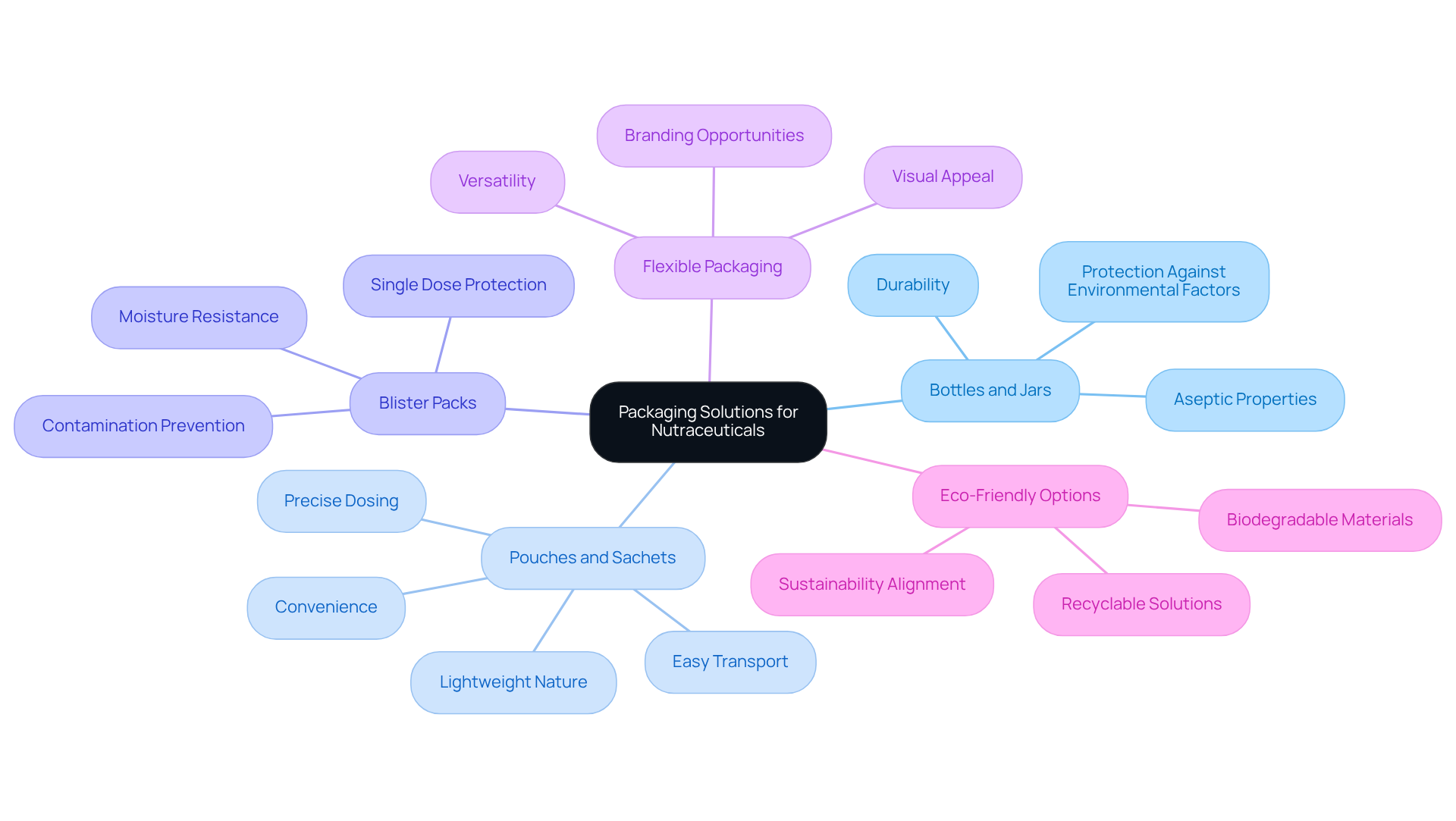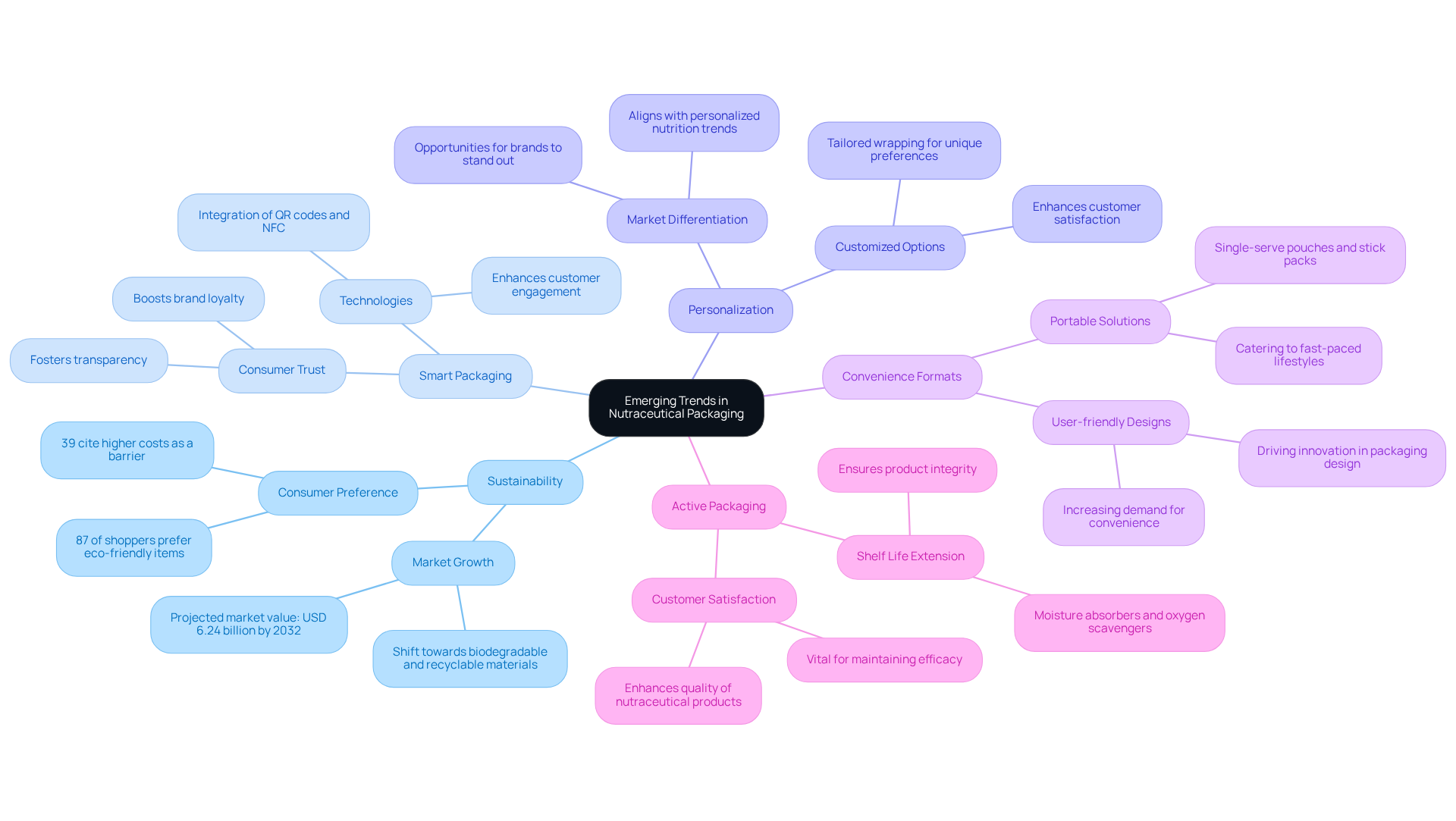Overview
This article delivers a comprehensive comparative analysis of various packaging solutions for nutraceuticals, underscoring their distinct advantages and disadvantages, including durability, convenience, and sustainability. The selection of packaging is significantly influenced by specific product requirements and consumer preferences. Notably, emerging trends such as eco-friendliness and smart packaging are driving innovation within the industry, highlighting the necessity for businesses to adapt and evolve in response to these shifts.
Introduction
Nutraceuticals are integral to modern health and wellness, yet the packaging solutions that safeguard and elevate these products are frequently underestimated. With the rise of eco-friendly alternatives and innovative technologies, the realm of nutraceutical packaging is swiftly transforming, propelled by consumer expectations and regulatory demands. As companies endeavor to bolster product integrity and enhance brand visibility, a pressing question emerges: which packaging solutions effectively address the diverse requirements of this evolving market?
This article embarks on a comparative analysis of various packaging types, examining their distinct advantages and potential limitations, while spotlighting emerging trends that are poised to shape the future of nutraceutical packaging.
Overview of Packaging Solutions for Nutraceuticals
Nutraceutical containers encompass a variety of solutions designed to safeguard, maintain, and enhance health items effectively. Key packaging types include:
- Bottles and Jars: These containers are widely utilized for vitamins and supplements, offering durability and protection against environmental factors, thereby ensuring product integrity.
- Pouches and Sachets: Increasingly popular for their convenience and lightweight nature, these formats facilitate easy transport and precise dosing, catering to on-the-go consumers. Western Packaging is committed to developing customized flexible containers, such as large pouches and stick packs, which enhance item attractiveness and meet specific consumer needs.
- Blister Packs: Ideal for single doses, blister packs provide exceptional protection against moisture and contamination, maintaining product efficacy.
- Flexible Packaging: This category includes stand-up pouches and rollstock, which are versatile and can be tailored for branding, enhancing visual appeal on shelves. Our innovative container design concepts, along with engaging graphic materials like labels and brochures, elevate brand awareness and shelf attractiveness, ensuring a cohesive and captivating brand identity.
- Eco-Friendly Options: With an increasing emphasis on sustainability, many producers are exploring biodegradable and recyclable materials to align with consumer preferences for environmentally responsible solutions.
Each of these packaging solutions, along with all packaging options, serves distinct purposes, addressing the diverse needs of the nutraceutical market by enhancing shelf life, improving convenience for buyers, and boosting brand visibility. Innovations in these areas are essential as the industry evolves to meet changing consumer demands and regulatory requirements.

Integrated Packaging and Logistics: Addressing Nutraceutical Challenges
The nutraceutical sector faces significant challenges, including stringent regulatory standards, the imperative for safety assurance, and the demand for efficient supply chain management. Integrated packaging and logistics solutions effectively address these critical issues by:
- Streamlining Operations: By consolidating packaging design, filling services, and logistics, companies can significantly reduce lead times and enhance product delivery efficiency.
- Enhancing Compliance: These combined approaches ensure that containers adhere to regulatory standards, which is essential for maintaining safety and fostering consumer trust.
- Improving Inventory Management: A unified approach facilitates superior tracking of inventory levels, minimizing waste and ensuring product availability when needed.
- Facilitating Customization: With integrated services, businesses can provide personalized options that cater to specific client needs, thereby boosting brand recognition and customer satisfaction.
This cohesive strategy not only simplifies the supply chain but also positions companies like Western Packaging as preferred partners for nutraceutical manufacturers aiming to optimize their operations. As the sector evolves, the integration of containers and logistics will be crucial in addressing the challenges posed by increasing health consciousness and the demand for preventive healthcare options.

Comparative Analysis of Packaging Solutions: Pros and Cons
A comparative analysis of packaging solutions for nutraceuticals reveals distinct advantages and disadvantages:
- Bottles and Jars: Durable, reusable, and effective for long-term storage. However, they can be bulky and less portable.
- Pouches and Sachets: Lightweight and convenient, ideal for single servings, yet they may offer less protection against external factors.
- Blister Packs: Provide excellent protection against moisture and contamination, but are restricted to individual doses, which may not suit all items.
- Flexible Packaging: Versatile and customizable, often more sustainable, though it may require additional support for structural integrity.
- Eco-Friendly Options: Align with consumer demand for sustainability, yet are often more expensive and may have limited availability.
This analysis highlights that while each packaging type has its strengths, the choice ultimately depends on the specific requirements of the nutraceutical product, including shelf life, consumer convenience, and branding considerations. With more than 60% of buyers prepared to spend extra for containers that are simple to open and store, the significance of user-friendly designs cannot be understated. Furthermore, the increase of flexible materials, which accounts for 19% of the $177 billion US market for containers, underscores a growing trend towards convenience and sustainability in the nutraceutical sector.

Emerging Trends in Nutraceutical Packaging
The nutraceutical container environment is rapidly evolving, shaped by shifting buyer preferences and technological advancements. Key emerging trends include:
- Sustainability: There is a significant shift towards eco-friendly packaging materials, such as biodegradable and recyclable options, reflecting consumers' increasing prioritization of sustainability. Recent statistics indicate that 87% of shoppers would purchase more eco-friendly items if they were easier to locate, underscoring its importance in buying decisions. This trend is further supported by market growth, driven by rising demand for dietary supplements and a preference for all packaging that is eco-friendly, as noted by Fortune Business Insights.
- Smart Packaging: The integration of technologies like QR codes and NFC is enhancing customer engagement by providing instant access to product information, thereby fostering trust and transparency. This innovation is becoming essential for brands looking to connect with health-conscious consumers.
- Personalization: Customized wrapping options tailored to unique buyer preferences are gaining traction, enabling brands to stand out in a competitive market. This trend aligns with the increasing focus on personalized nutrition, presenting unique opportunities for differentiation. A notable development in the nutraceutical container sector is the rise of these customized wrapping options, which can significantly enhance customer satisfaction.
- Convenience Formats: Portable solutions, such as single-serve pouches and stick packs, are becoming increasingly popular as consumers seek convenience in their health products. This demand for user-friendly formats is driving innovation in all packaging design, catering to the fast-paced lifestyles of modern shoppers.
- Active Packaging: Technologies that extend shelf life, including moisture absorbers and oxygen scavengers, are being adopted to ensure product integrity and enhance customer satisfaction. These advancements are vital for maintaining the quality of all packaging associated with nutraceutical products.
These trends highlight a dynamic market where containers must continually adapt to meet the evolving demands of both consumers and producers. Specific case studies, such as the partnership between Berry Global and Printpack to create sustainable packaging solutions, exemplify successful implementations of these practices within the industry.

Conclusion
The exploration of packaging solutions for nutraceuticals underscores the critical role that effective packaging plays in preserving product integrity and enhancing consumer experience. This analysis reveals that various packaging types, from bottles and jars to eco-friendly options, each serve unique purposes while addressing the diverse needs of the nutraceutical market.
Key arguments highlight the benefits of integrated packaging and logistics, which streamline operations and ensure compliance with regulatory standards. Additionally, the comparative analysis of different packaging solutions illustrates the strengths and weaknesses of each type, emphasizing the importance of user-friendly designs and sustainability in meeting consumer expectations. Emerging trends such as smart packaging, personalization, and active packaging further illustrate the industry's evolution, driven by technological advancements and shifting buyer preferences.
As the nutraceutical sector continues to grow, embracing innovative packaging solutions will be essential for companies aiming to stand out in a competitive market. By prioritizing sustainability and convenience, brands can not only enhance their product offerings but also foster consumer loyalty. The future of nutraceutical packaging lies in adaptability and responsiveness to market demands, making it imperative for stakeholders to stay informed and proactive in their packaging strategies.
Frequently Asked Questions
What are nutraceutical containers?
Nutraceutical containers are packaging solutions designed to safeguard, maintain, and enhance health items, including vitamins and supplements.
What types of packaging are commonly used for nutraceuticals?
Common packaging types for nutraceuticals include bottles and jars, pouches and sachets, blister packs, flexible packaging, and eco-friendly options.
What are the benefits of using bottles and jars for nutraceuticals?
Bottles and jars offer durability and protection against environmental factors, ensuring the integrity of vitamins and supplements.
Why are pouches and sachets becoming popular in the nutraceutical market?
Pouches and sachets are lightweight and convenient, facilitating easy transport and precise dosing, which appeals to on-the-go consumers.
What are blister packs used for in nutraceutical packaging?
Blister packs are ideal for single doses, providing exceptional protection against moisture and contamination while maintaining product efficacy.
What does flexible packaging include and what are its advantages?
Flexible packaging includes stand-up pouches and rollstock, which are versatile and can be tailored for branding, enhancing visual appeal on shelves.
How are eco-friendly options being incorporated into nutraceutical packaging?
Many producers are exploring biodegradable and recyclable materials to create packaging that aligns with consumer preferences for environmentally responsible solutions.
What is the significance of innovations in nutraceutical packaging?
Innovations in packaging are essential for addressing changing consumer demands and regulatory requirements, enhancing shelf life, improving convenience, and boosting brand visibility.




